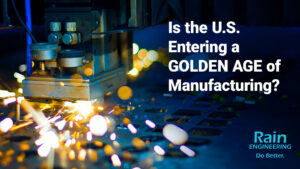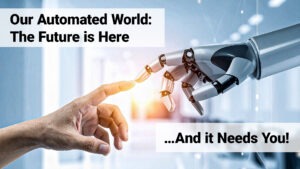
Is the U.S. Entering a GOLDEN AGE of Manufacturing?
Is the U.S. Entering a GOLDEN AGE of Manufacturing? For decades, the story of American manufacturing has followed a slow and steady arc of decline.
This past weekend, comedian Bill Maher sparked an insightful conversation on his HBO show Real Time with Bill Maher, where he questioned whether the United States should even try to regain its dominance in global manufacturing.
Maher argued that manufacturing seemed like a relic of the past, reminiscent of the 1970s, and instead suggested that the U.S. should focus its efforts on emerging industries like artificial intelligence (AI), which he sees as more aligned with the future.
Maher’s perspective, though valid in its concern for technological progress, overlooks the importance of revitalizing the U.S. manufacturing sector.
While AI and other advanced technologies are undoubtedly the industries of tomorrow, there are compelling reasons why manufacturing remains crucial to the country’s long-term economic and strategic interests.
Today, let’s discuss why investing in both manufacturing AND AI, the U.S. can create a symbiotic relationship between the two, where innovation in one sector drives progress in the other.
To understand why the U.S. should care about reclaiming its manufacturing prowess, it’s necessary to examine the state of the industry.
Over the past few decades, U.S. manufacturing has suffered significant decline due to globalization, outsourcing, and automation.
Much of the production of goods has shifted overseas, especially to countries with lower labor costs.
As a result, manufacturing has accounted for a smaller portion of the U.S. economy, while sectors like services, finance, and technology have surged.
However, abandoning manufacturing altogether could leave the U.S. vulnerable, both economically and strategically.
National security is one key concern—during times of crisis, such as wars, natural disasters, or supply chain disruptions, a strong domestic manufacturing base is essential.
The U.S. needs to be able to produce vital goods like medical supplies and defense equipment without relying on other countries, especially those with adversarial relationships.
The global semiconductor shortage, for example, revealed just how reliant the U.S. is on foreign countries for critical technology.
Rebuilding domestic manufacturing would reduce this dependency and ensure the country can meet its needs when times are tough.
Manufacturing also plays an important role in the economy.
Reinvesting in this sector would create millions of high-quality jobs—especially in advanced fields like robotics, aerospace, and clean energy.
While automation is reshaping the industry, there will still be demand for skilled workers who can design and maintain these systems.
Strengthening manufacturing would boost the economy, attract investments, and create a robust job market for Americans at all levels of education and expertise.
In addition, a revitalized manufacturing sector would make the U.S. more resilient to global supply chain disruptions, as seen during the COVID-19 pandemic.
The vulnerabilities of relying on other countries for essential goods became starkly evident when the pandemic shut down production lines and interrupted shipping.
By bringing more manufacturing jobs back to the U.S., the country could reduce its dependence on foreign markets and ensure a more self-sufficient and stable economy.
Furthermore, a robust manufacturing base is crucial for technological advancement.
Modern manufacturing isn’t about outdated assembly lines—it’s about cutting-edge processes that support high-tech industries.
The future of industries like electric vehicles, renewable energy, and 5G infrastructure hinges on advanced manufacturing techniques.
The U.S. must lead in these areas to remain globally competitive, and manufacturing is central to this effort.
Rather than viewing manufacturing and AI as separate or opposing forces, the U.S. has a unique opportunity to harness both in a way that propels each sector forward.
AI and manufacturing can complement one another in ways that drive efficiency, innovation, and progress across industries.
For example, AI is already revolutionizing manufacturing by optimizing production lines, improving quality control, and minimizing waste.
AI-powered robots and machines are transforming factories, increasing efficiency while lowering costs.
By investing in AI, the U.S. can enhance its manufacturing sector, making it smarter and more capable of competing with other nations.
At the same time, the revitalization of manufacturing can create a new wave of skilled jobs in fields like AI, robotics, and data science.
As manufacturing becomes increasingly automated and integrated with AI technologies, some workers will need to acquire new skills to keep pace, but this shift offers an opportunity to build a knowledge-based economy in which workers are equipped to thrive in both manufacturing and AI-focused roles.
Universities, vocational schools, and corporate training programs can play a key role in preparing workers for these high-tech jobs, ensuring the U.S. remains competitive on the global stage.
Moreover, AI’s potential extends beyond improving production efficiency—it can also drive innovation in the materials used in manufacturing.
Machine learning algorithms can help discover new, more efficient materials, such as lighter, stronger, or more sustainable substances, which can transform industries like aerospace, automotive, and construction.
By integrating AI with manufacturing, the U.S. can not only enhance product quality but also contribute to environmental sustainability by reducing waste and energy consumption.
In the face of global competition, particularly from countries like China, the U.S. must position itself as a leader in both manufacturing and AI.
China has made significant investments in both sectors, and if the U.S. is to maintain its edge, it will need to leverage its technological strengths and ensure that manufacturing is not left behind.
By combining the strengths of both industries, the U.S. can create an ecosystem where innovation and economic growth are propelled forward by the synergy of AI and manufacturing.
While Bill Maher’s take on manufacturing highlights the shift toward new technologies and industries, the U.S. would be wise to consider a future where both manufacturing and AI thrive together.
Instead of abandoning manufacturing in favor of newer technologies, the U.S. should view the two as complementary forces—each driving progress in the other.
A strong domestic manufacturing base ensures national security, creates jobs, and lays the foundation for technological innovation, while AI can enhance manufacturing processes and lead to groundbreaking advancements in materials, production, and efficiency.
By investing in both sectors, the U.S. can secure its position as a global leader, not only in AI but in advanced manufacturing as well.
Remember, the future isn’t about defeating our past—it’s about finding ways for them to work together, pushing the boundaries of what’s possible, and ensuring we remain resilient and competitive in this ever-changing world.
P.S. Are you attending Accelerate 2025? If so, be sure to set aside time on Wednesday, March 19th for two insightful panel discussions featuring Rain Engineering’s Don Rahrig alongside industry leaders from EY, RoviSys, Papa Johns’s International, GE Vernova, and more.
Don’t miss this opportunity!
Get ready to explore the future of manufacturing and CLOUD MES implementation with some of the best minds in the industry.

Is the U.S. Entering a GOLDEN AGE of Manufacturing? For decades, the story of American manufacturing has followed a slow and steady arc of decline.

Forging Our Prosperous Future: Why Collaboration Is the Cornerstone of Modern Manufacturing The manufacturing world is undergoing one of its most dramatic transformations in recent

Our Automated World: The Future is Here (… And it Needs You!) AI and automation are no longer creeping into manufacturing—they’ve arrived, settled in, and

Rare Earth Minerals and the Manufacturer’s Dilemma: How Global Politics and Critical Materials are Shaping the Future of American Industry In today’s industrial landscape, manufacturers

Manufacturing’s Quiet Crisis: The Generational Divide That’s Reshaping Industrial Work The manufacturing industry is standing on the edge of a transformation that reaches far beyond

Ready to Explore the Future of Manufacturing? As global markets become more volatile and customer demands shift faster than ever, manufacturers are at a critical
